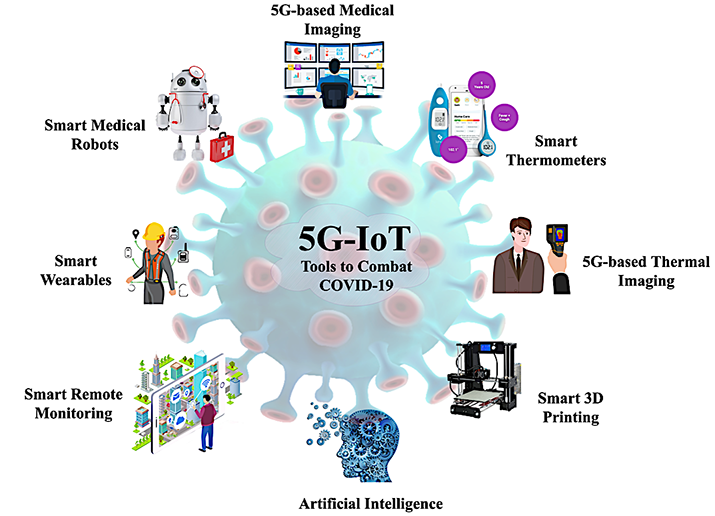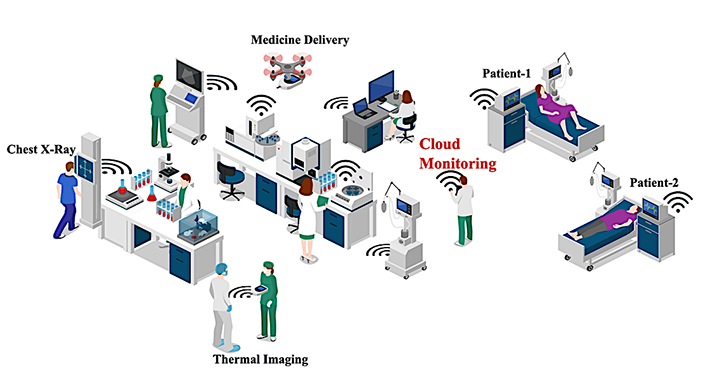5G-IoT in the Battle Against COVID-19: Prospects and Challenges
Corona Virus Disease 2019 (COVID-19) was first detected in China towards the end of December 2019 and is still spreading throughout the world. According to the World Health Organization (WHO), within the past six months (January 2020 to June 2020), 216 countries and regions worldwide have testified more than 13 million infected people, comprising more than 0.5 million deaths.
COVID-19 is a respirational infection triggered by strict perceptive respiratory syndrome Corona Virus-2 (SARS-CoV-2) [1][2]. There is no concrete strategy for its treatment yet, but social distancing is recognized as the only defending strategy against this epidemic.
Moreover, the crisis of the COVID-19 outbreak has introduced a shock for both the economic and labor marketplace. It has affected the supply (production of goods and services) and its mandate (consumption and investment). According to up-to-date estimation, the COVID-19 can slender the world economic growth from 3.0% up to 6.0% in 2020. The partial recovery is expected in 2021 with consideration of no second wave of infections [3]. At the moment, all trades, disregarding its size, face severe challenges, leading to the risk of decays in revenue, bankruptcies, and job fatalities in many sectors (aviation, tourism, hospitality, and industries).
The most effective way to stop the blowout of COVID-19 and re-open the businesses is to track the social distancing. As social distancing is the new norm to fight this pandemic where digital technologies can play a significant role [4]. Several countries around the globe have used smart technologies to keep social distancing, provide contact tracing, and enable intelligent lockdowns. Thus, the world has become in great need of emergent technologies than before, such as (artificial intelligence (AI), autonomous drones, Big-data analytics, smart robotics, and the internet of things (IoT)). These technologies have enhanced the combat against COVID-19, including the newly commercialized 5G technology.
Smart technologies can effectively work in epidemic crisis management due to their time-saving capability, strengthening automation, and reducing human involvement. Furthermore, they are also capable of making society more resilient to face such pandemics and similar threats. Therefore, in this paper, we emphasize the IoT technology connected to the 5G network, which shows a vital position in the present pandemic era by contributing to limiting the spread of the virus and enabling other various applications (see Fig. 1 for applications of 5G-IoT in fighting the pandemic). In this perspective, we show that the implementation of IoT and 5G together under the term “5G-IoT”, has the potential to combat the virus and save the global economy in different sectors (healthcare, education, media, etc.).

Figure 1: 5G-IoT tools to combat COVID-19.
The IoT technology is creating a considerable surge of smart, linked devices that may facilitate newer applications and services. One of the most well-known IoT applications is in medicine termed as the internet of medical things (IoMT). Applications of IoMT include tracing of medication orders, remote health monitoring, and sharing the data using wearables to the respective health care experts. In the following, we present some of the trending applications of IoT in battling against COVID-19.
- Smart Thermometers: IoT-enabled smart thermometers are employed by hospitals to screen patients and staff. For instance, Shanghai Public Health Clinical Center (SPHCC), in collaboration with other specialized field hospitals, is presently using smart temperature sensors to observe COVID-19 patients [5]. Similarly, in the US, Kinsa Health debuted its internet-connected thermometers to track the flu spread. Kinsa Health is uploading the sensing data for free to government and research scientists to pinpoint where the next outbreak might occur and which communities are flattening the curve. They’re also proving that social distancing is working [6].
- Smart Wearables: Researchers at Istituto Italiano di Tecnologia (IIT) designed sensors-based suits that can monitor the physical structure parameters, which warn users when their body temperature exceeds 37.50. These wearables are also capable of recording the body’s movement and broadcast radio signals from which the gap from another bracelet may be extracted. They even start vibration when two smart-bands come into each other proximity, hence alerting the people to esteem social distancing. The radio wave frequency is 2.45 GHz, identical to Bluetooth. In contrast, the IIT established an exclusive method for a neater and quicker revealing of human proximities. Similarly, in Hong Kong, the researchers use wristbands with an electronic tracker that alerts the authorities when individuals arrive from international destinations and do not necessarily require home quarantines [5].
- IoT buttons: Lately, IoT-buttons are introduced to send quicker alerts to the managing team regarding preservation and cleaning problems to ensure public safety. The IoT-buttons not only keep informing the facility managers to keep an eye on the response time of working for staff but also allow them to monitor the cleaning activities. The buttons are efficient enough to send the alert issued by a staff member or general public to a specific department that might adhere to any infrastructure. It should be noted that these IoT-buttons are battery-operated and automatically connected with long-term evolution machine type communication (LTE-M) network. They can be utilized in patient rooms, restrooms, nursing counters, and public places [5].
IoT when combined with the 5G technology can make a great enhancement to the IoT technology by connecting billions of intelligent devices, which are mutually interacting and exchanging data with no human intervention [7], [8]. In the following, we briefly discuss some of these 5G-based applications.
- 5G+ Medical Imaging: With the 5G+ systems and tools like AI and Big-data analytics, picture archiving, and- communication systems (PACS) can improve data investigation with nominal human effort. For instance, 5G-enabled medical imaging systems are deployed in Wuhan province in various specialized hospitals for real-time identification of COVID-19 patients and to secure the hospital staff from getting infected [9].
- 5G+ Thermal Imaging: The establishment of 5G networks has improved 5G-enabled thermal imaging systems with numerous use cases in the healthcare sector. For instance, 5G+ based thermal imaging is gaining higher importance, adequately monitoring the temperature of the public around-the-clock during this pandemic (see Fig. 2). Several 5G+ thermal imaging systems function in China in the form of smart medical robots and unmanned aerial vehicles (UAVs), which are deployed at different public places in numerous cities to minimize the increase of the pandemic [9].
- 5G Remote Platforms: The 5G-based remote platforms can undoubtedly improve the effectiveness and efficiency of consultation with doctors online. This allows the physicians to carry out the consultation via teleconferencing with the patients without their physical presence, reducing the risk of exposure to the virus, and saving commuting time. Moreover, the 5G inaccessible imaging diagnosis manifestos can further improve alliance in the healthcare industry.
- 5G-enabled Smart Medical Robots: During the COVID- 19 epidemic, different attempts have been made around the world to develop smart medical robots. These smart robots are capable enough to ease the burden of health-care staff and help them in other medical utilities. Furthermore, the smart robots that are 5G-enabled are more precise and efficient in carrying out the assigned tasks to assist in taking care of the quarantined patients.

Figure 2:5G-IoT enabled smart healthcare system amid COVID-19.
References
- C.-C. Lai, T.-P. Shih, W.-C. Ko, H.-J. Tang, and P.-R. Hsueh, “Severe acute respiratory syndrome coronavirus 2 (SARS-CoV-2) and corona virus disease-2019 (COVID-19): The epidemic and the challenges,” Int. journal of antimicrobial agents, p. 105924, 2020.
- W. H. Organization, “Corona virus disease (COVID-19),” 2019. [Online]. Available: https://www.who.int/emergencies/diseases/novel-coronavirus-2019
- J. Jackson, M. Weiss, A. Schwarzenberg, and R. Nelson, “Global Economic Effects of COVID-19,” p. 78, 2020.
- N. Saeed, A. Bader, T. Y. Al-Naffouri, and M.-S. Alouini, “When wireless communication faces COVID-19: Combating the pandemic and saving the economy,” Frontiers in Communications and Networks, 2020.
- M. Choudhary, “How IoT can help fight COVID-19 battle,” May 2020. [Online]. Available: https://www.geospatialworld.net/blogs/how-iot-can-help-fight-covid-19-battle/
- V. Chamola, V. Hassija, V. Gupta, and M. Guizani, “A Comprehensive Review of the COVID-19 Pandemic and the Role of IoT, Drones, AI, Blockchain, and 5G in Managing its Impact,” IEEE Access, vol. 8, pp. 90 225–90 265, 2020.
- S. K. Goudos, P. I. Dallas, S. Chatziefthymiou, and S. Kyriazakos, “A Survey of IoT Key Enabling and Future Technologies: 5G, Mobile IoT, Sematic Web and Applications,” Wireless Personal Communications, vol. 97, no. 2, pp. 1645–1675, 2017.
- Y. Siriwardhana, C. De Alwis, G. Gu ̈r, M. Ylianttila, and M. Liyanage, “The fight against the COVID-19 pandemic with 5G technologies,” IEEE Engineering Management Review, vol. 48, no. 3, pp. 72–84, 2020.
- “Huawei and Deloitte publish a white paper on how 5G is helping fight COVID-19,” Mar. 2020. [Online]. Available (in French): https://www.agenceecofin.com/
industrie/2003-74982-huawei- et-deloitte-collaborent-sur- un-livre-blanc-relatif-a-la- lutte-contre-la-covid-19-avec- la-5g - D. Li, “5G and intelligence medicine?how the next generation of wireless technology will reconstruct healthcare?” Precision Clinical Medicine, vol. 2, no. 4, pp. 205–208, 2019.
- C. T. Nguyen, Y. M. Saputra et al., “Enabling and emerging technologies for social distancing: A comprehensive survey,” arXiv preprint arXiv:2005.02816, 2020.
 Nasir Saeed (Senior Member, IEEE) is currently working as an Associate Professor at the Department of Electrical Engineering, National University of Technology (NUTECH), Islamabad, Pakistan. Dr. Saeed is also a member of the technical program committee for various IEEE conferences, such as ICCC, GLOBECOM, and VTC. He is also serving as an Associate Editor for Frontiers in Communications and Networks. Dr. Saeed has participated in various projects in KAUST relevant to communications, localization, and networking in extreme environments. His current areas of interest include cognitive radio networks, underwater and underground wireless communications, satellite communications, dimensionality reduction, and localization.
Nasir Saeed (Senior Member, IEEE) is currently working as an Associate Professor at the Department of Electrical Engineering, National University of Technology (NUTECH), Islamabad, Pakistan. Dr. Saeed is also a member of the technical program committee for various IEEE conferences, such as ICCC, GLOBECOM, and VTC. He is also serving as an Associate Editor for Frontiers in Communications and Networks. Dr. Saeed has participated in various projects in KAUST relevant to communications, localization, and networking in extreme environments. His current areas of interest include cognitive radio networks, underwater and underground wireless communications, satellite communications, dimensionality reduction, and localization.
 Rania Djechaiche (Student Member, IEEE) is currently a Ph.D. student of Electronics and Telecommunications Systems, Faculty of Technology, University of Mohamed Bachir-El-Ibrahimi, Algeria. She has developed mobile applications in transport technology, electronic health, and home automation. Her main research interests focus on contemporary technological advancements including M2M Communications, Internet of Things, Network Security, Machine Learning, Artificial Intelligence, Neural Networks, and 5G Networks.
Rania Djechaiche (Student Member, IEEE) is currently a Ph.D. student of Electronics and Telecommunications Systems, Faculty of Technology, University of Mohamed Bachir-El-Ibrahimi, Algeria. She has developed mobile applications in transport technology, electronic health, and home automation. Her main research interests focus on contemporary technological advancements including M2M Communications, Internet of Things, Network Security, Machine Learning, Artificial Intelligence, Neural Networks, and 5G Networks.
 Ruhul Amin Khalil (Graduate Student Member, IEEE) is currently pursuing a Ph.D. degree in Electrical Engineering at the Department of Electrical Engineering, University of Engineering and Technology Peshawar, Pakistan. His present research interests include the Internet of Things, Routing, localization, Network Traffic Estimation, Software Defined Networks, and underwater wireless communication.
Ruhul Amin Khalil (Graduate Student Member, IEEE) is currently pursuing a Ph.D. degree in Electrical Engineering at the Department of Electrical Engineering, University of Engineering and Technology Peshawar, Pakistan. His present research interests include the Internet of Things, Routing, localization, Network Traffic Estimation, Software Defined Networks, and underwater wireless communication.
Sign Up for IoT Technical Community Updates
Calendar of Events
IEEE 8th World Forum on Internet of Things (WF-IoT) 2022
26 October-11 November 2022
Call for Papers
IEEE Internet of Things Journal
Special issue on Towards Intelligence for Space-Air-Ground Integrated Internet of Things
Submission Deadline: 1 November 2022
Special issue on Smart Blockchain for IoT Trust, Security and Privacy
Submission Deadline: 15 November 2022
Past Issues
September 2022
July 2022
March 2022
January 2022
November 2021
September 2021
July 2021
May 2021
March 2021
January 2021
November 2020
July 2020
May 2020
March 2020
January 2020
November 2019
September 2019
July 2019
May 2019
March 2019
January 2019
November 2018
September 2018
July 2018
May 2018
March 2018
January 2018
November 2017
September 2017
July 2017
May 2017
March 2017
January 2017
November 2016
September 2016
July 2016
May 2016
March 2016
January 2016
November 2015
September 2015
July 2015
May 2015
March 2015
January 2015
November 2014
September 2014


